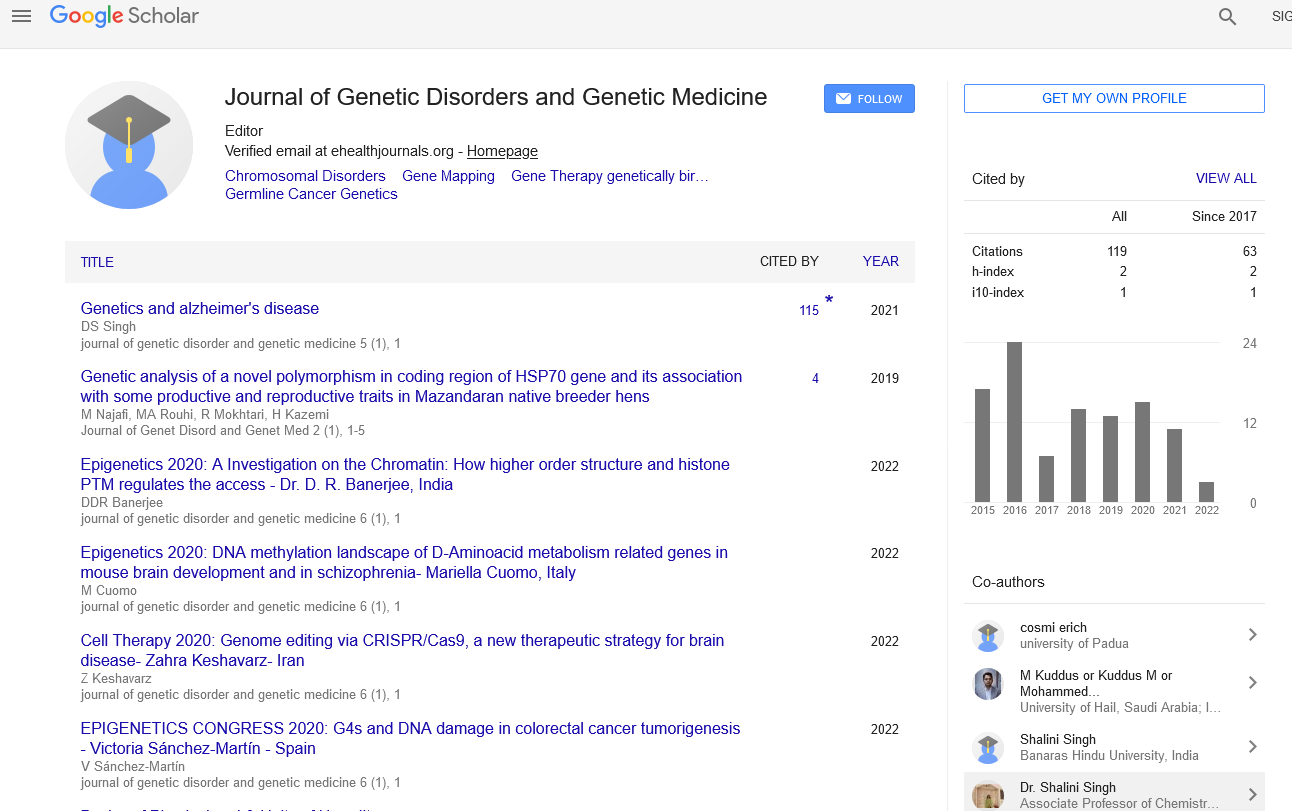Genetics and alzheimer's disease
Received: 05-Sep-2017 Accepted Date: Sep 07, 2017; Published: 14-Sep-2017
Citation: Singh S. Genetics and alzheimer's disease. J of Genet Disord and Genet Med. 2017;1(1):1.
This open-access article is distributed under the terms of the Creative Commons Attribution Non-Commercial License (CC BY-NC) (http://creativecommons.org/licenses/by-nc/4.0/), which permits reuse, distribution and reproduction of the article, provided that the original work is properly cited and the reuse is restricted to noncommercial purposes. For commercial reuse, contact reprints@pulsus.com
Every aspect of human health is underlined by our genes, both in function and dysfunctions. Possessing a detailed understanding of how genes work together and interact with environmental factors will ultimately allow us to appreciate the differences between the events in normal cellular process and those that occur in pathogenic diseases. Such knowledge will have a significant impact on the way many diseases are defined, diagnosed, treated and prevented. Genetic insight is expected to bring about revolutionary changes in medical practices [1]. Nearly, 5000 genetic diseases are known to afflict people but this is almost certainly an underestimate. Among them, one is the Alzheimer’s disease. The cause of Alzheimer’s diseases is believed to be genetic with many genes involve and other cause is less secretion Carbonic Anhydrase. Carbonic anhydrase (CAs,Ec 4.2.1.1) are ubiquitous in all kingdom, starting with Archaea, bacteria, algae and green plants and ending with superior animals including vertebrates. CA characterized metlloenzyme, containing one zinc ion (Zn2+) per poly peptide chain. The main physiological function of CAs is to catalyze the reversible hydration of carbon dioxide to bicarbonate ion, maintain acid-base balance in blood and help transport carbon dioxide out of tissues. Inhibition (but also activation) of these enzymes may be exploited clinically in the treatment or prevention of variety of disorders. A multitude of physiologically significant compounds such as amino acids, oligopeptides or small proteins, as well as many biogenic amines (histamine, serotonin, and catecholamine’s among others), were shown to well activate the catalytic activity of isoforms of the metalloenzyme carbonic anhydrase (CA,EC 4.2.1.1) which acts as an efficient catalyst for the inter conversion between carbon dioxide and bicarbonate at neutral pH [2]. The report shows that [3] some CAAs (such as phenylalanine and imidazole) administered to experimental animals may produce an important pharmacological improvement of synaptic effectiveness, spatial learning, and memory proves that this class of relatively unexplored enzyme modulators may have pharmacological applications in conditions in which learning and memory are impaired, such as for example Alzheimer’s disease or aging. One must also mention that it was previously reported that the levels of CA are significantly diminished in the brain of patients affected by Alzheimer’s disease [4] and CA isozimes were investigated for their interaction with a large number of amine and amino acid activators. Activation of mammalian CAs by various classes of activators, may lead to the design of pharmacologically useful derivatives for the enhancement of synptic efficacy, which may represent a conceptually new approach for the treatment of depression, Alzheimer’s disease [5,6]. Other curable aspect of Alzheimer is Brahmi (Bacopa monnier). Bacopa is a medicinal herb used in Ayurveda, where it is also known as “Brahmi”, after Brahma, the creator God of the Earth (according Hindu Methodology). Therefore, the brahmi prevents ageassociated memory in elderly.
REFERENCES
- Robert J Brooker. Mcgraw. Genetics Analysis & principles. Hill International Edition.
- Supuran CT, Parkkila S. Characterization and inhibition of the recently discovered carbonic anhydrase isoforms CA XIII, XIV and XV. Curr Top Med Chem 2007;7: 825.
- Scozzafava A, Supuran, CT. Inhibition of carbonic anhydrase IX as a novel anticancer mechanism. Expert Opin Ther Pat 2006;16: 1627-64.
- Sun MK, Alkon DL. Pharmacological enhancement of synaptic efficacy, spatial learning and memory through carbonic anhydrase activation in rats. J Pharmacol Exp Ther 2001;297: 961-7.
- Meier Ruge W, Iwangoff P, Reichlmeier K. Neurochemical enzyme changes in Alzheimer’s and Pick’s disease. Arch Gerontol Geriatr 1984;3: 161-5.
- Temperenic, Scozzafavaa, VulloD, et al. Carbonic Anhydrase Activators. Activation of Isoforms I, II, IV, VA, VII, and XIV with l- and d-Phenylalanine and Crystallographic Analysis of Their Adducts with Isozyme II: Stereospecific Recognition within the Active Site of an Enzyme and Its Consequences for the Drug Design. J Med Chem 2006;49: 3019-27.





